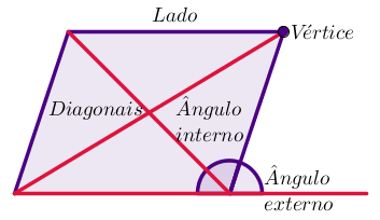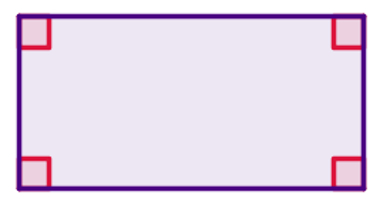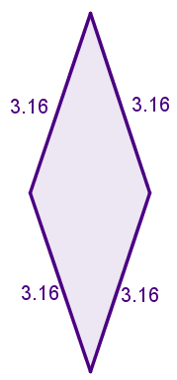parallelograms are geometric figures that have only four sides, the opposite sides being parallels. This means that opposite sides of a parallelogram are straight segments belonging to straight lines that do not touch at any point. To verify this, it would be necessary to draw the extension of the sides of a parallelogram infinitely.

Elements of parallelograms
You parallelograms they are quadrilaterals, because they are polygons that have exactly four sides, and convex. For this reason, they inherit all the elements and properties of the convex polygons and quadrilaterals. Look:
sides: the sides of a parallelogram are the straight segments that compose it;
Vertices: are the meeting points between two sides of a parallelogram;
diagonals: are the straight lines that connect two non-consecutive vertices. The parallelograms have only two diagonals;
internal angles: are the angles formed by two adjacent sides of a parallelogram. You parallelograms have four inner angles;
outside angles: are the angles formed, outside the polygon, by the extension of one side and the side adjacent to it. You
parallelograms they also have four outside angles.

Properties of parallelograms
the opposite sides of a parallelogram are congruent and parallel;
The opposite angles of a parallelogram are congruent;
adjacent angles of a parallelogram they are supplementary (their sum equals 180°);
The sum of the outside angles of a parallelogram is always equal to 360°;
The sum of the internal angles of a parallelogram is always equal to 360°;
throughout parallelogram, the sum of an inner angle and an outer angle adjacent to it equals 180°;
the diagonals of a parallelogram intersect at their midpoints.
You parallelograms can be classified according to their measurements. The groups are: others, which bring together any parallelograms; rectangles; diamonds and squares.
rectangles
They are parallelograms that have internal angles straight. Thus, its external angles are also straight and its shape is the same as the following figure:

The specific property of the rectangle is related to its diagonals: the diagonals of a rectangle are congruent and meet at their midpoints. So every rectangle is a parallelogram, but not every parallelogram is a rectangle.
Diamond
You diamonds they are parallelograms that have all congruent sides. Note that the definition does not involve angles, therefore, they form figures similar to the one in the following image:

the diagonals of the diamond they are perpendicular and meet at their midpoints. Note that every diamond is a parallelogram, but not every parallelogram is a diamond.
squares
the squares are parallelograms which are diamonds and rectangles simultaneously. Therefore, squares, in addition to having all sides equal, also have right angles. The diagonals of a square are perpendicular and congruent.

Example of square
Note that the squares are also are diamonds and rectangles, but not every diamond or rectangle is square. Also, a diamond that has right angles is also a square. Likewise, a rectangle of congruent sides is also a square.
By Luiz Paulo Moreira
Graduated in Mathematics
Source: Brazil School - https://brasilescola.uol.com.br/o-que-e/matematica/o-que-e-paralelogramo.htm


